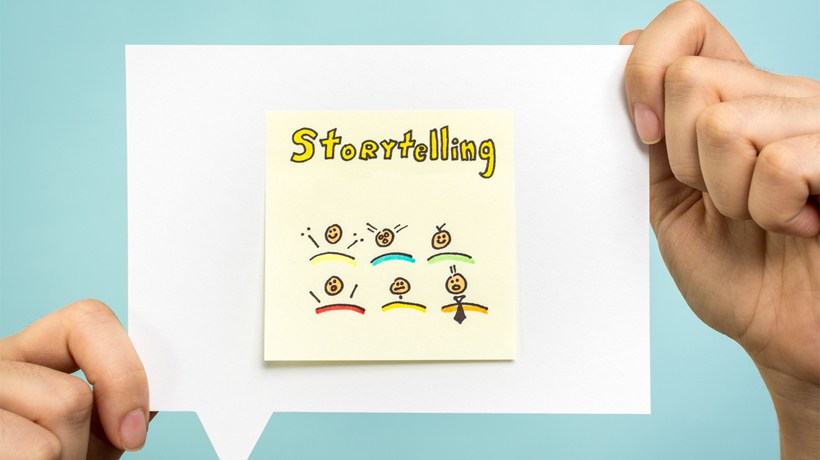7 Tips And Tricks To Include Storytelling In eLearning
Storytelling in eLearning might seem easy enough. You brainstorm a few characters, toss them into the middle of a realistic environment, and put some obstacles in their way. But there is a lot more to spinning yarns and telling tall tales. eLearning professionals must be able to create persuasive eLearning stories that motivate online learners and foster an emotional connection. We have to make them feel for the eLearning characters and their plight, and then tie it all into real world benefits, objectives and applications. Here are 7 tips to help you take on the storytelling challenge and write a winning tale for your online learners.
- Follow the story arc.
Every eLearning story should follow an arc that introduces the eLearning character or situation, gradually builds up to a conflict or challenge, and then offers a resolution. You cannot suddenly thrust your online learners into the middle of the action and expect them to sympathize with the protagonist or get emotionally invested in the eLearning story. On the other hand, they don't want to spend 10 minutes familiarizing themselves with the eLearning characters, only to discover that there is no point to the plot. This is why it's imperative to create a structure for your eLearning story and ensure that includes the all-important arc. - Create the perfect "hook".
You need to grab your online learners' attention right from the start. Keep in mind that they don't have a lot of time to participate in eLearning experience, and they are dealing with distractions on a regular basis, especially if they are accessing the eLearning course on their mobile device. Lead off with an attention grabbing statement or question that prompts them to continue reading. Challenge their assumptions or pique their curiosity. Just make sure that it doesn’t push the boundaries too far or offend members of our audience. For example, you probably don't want to start your eLearning story with profanity. It might grab their attention, but it's also going to make them uncomfortable. - Evoke emotion.
The main purpose of storytelling in eLearning is to create an emotional connection with your audience. You want them to feel what the eLearning characters are feeling and to see how they can use the information in their own lives. Creating the perfect plot and developing your eLearning characters is important, but cultivating an emotional atmosphere should be a top priority. Before you start crafting your eLearning story identify which emotions you want to convey. Do you want them to feel a sense of fear? Are they supposed to feel inspired by the eLearning characters' actions? Describe how your main protagonist feels and reveal the true nature of an eLearning character in order to create emotional depth. - Keep it action-packed.
Nobody wants to read a flat eLearning story that meanders through the plot at a snail's pace. We want action, suspense, and drama. When you are crafting your eLearning story, consider the relevance of each detail. Do your online learners really need to know how a room looks or what an eLearning character is thinking? Remove any events that seem out of place or extraneous details that don't add to the plot. Every item in your eLearning story should contribute to the emotional atmosphere or shed light on an eLearning character's motivation. That being said, it's also important to have some ups and downs in your eLearning story. Not every second can be filled with explosive action. Include moments where the eLearning character reflects on an event or evaluates the situation. - Make your eLearning story multi-sensory.
Your online learners are already reading the eLearning story, so that takes care of the visual component in eLearning. However, multi-sensory eLearning stories are much more effective. There are two ways to achieve this: by writing it directly into your eLearning story or by including multimedia. You can write it into your eLearning story by using imagery and descriptors. For example, describing how something feels or tastes. This helps your online learners to create a complete picture within their minds. The alternative is integrating multimedia, such as images, background music, and sound effects. - Create an obstacle.
We all must overcome problems and challenges in our lives, and we expect the characters in our eLearning stories to do the same. This is not to say that you have to include extreme obstacles, such as life-altering events or monsters that must be slayed. In fact, everyday challenges are usually more effective. For example, a workplace conflict can be a great addition to your eLearning story. Just make certain that you offer a resolution to the problem and describe HOW the protagonist overcame the obstacle. This gives your online learners the information and tools they need to resolve the issue when they encounter it in their own lives. - Catch online learners by surprise.
Online learners love a good plot twist. They enjoy being surprised or being caught off guard, particularly when they are already invested in the story. Brainstorm a variety of different outcomes for your eLearning story and then choose the one that your online learners would least expect, provided that it still makes sense and is relevant. You can also include minor plot twists throughout the eLearning story that keep online learners on the edge of their seats. There is a caveat: don't make the twist the focal point of your eLearning story. It's perfectly alright for online learners to talk about the twist after they complete the eLearning course, but they should also remember the key takeaways.
The secret to crafting amazing eLearning stories is to plan out every element in advance. Create a detailed outline that covers your eLearning characters, storyline, and key takeaways. Always keep the learning goals and objectives in sight, and remember that literary devices should never overshadow the subject matter.
Would you like to learn more how to integrate storytelling in eLearning design? Read the article 7 Tips To Integrate Storytelling Into Your Next eLearning Course to discover how to integrate storytelling in eLearning design in order to create a highly effective and engaging eLearning experiences for your online learners.









